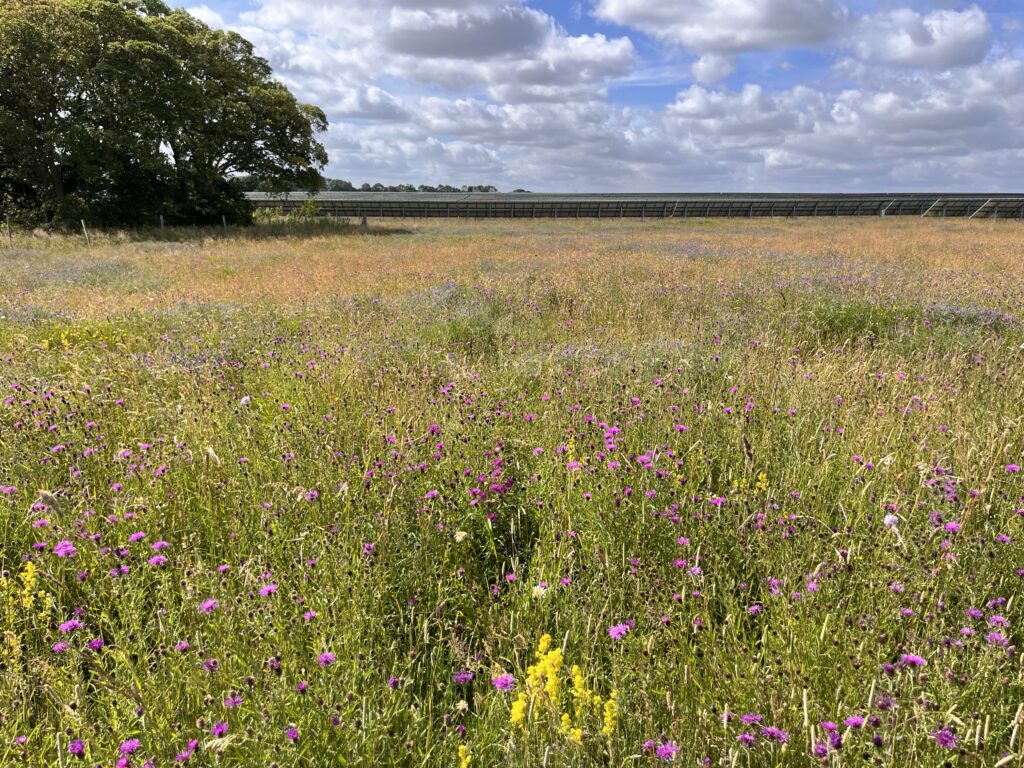In this article for Pensions Aspects magazine, Ecologist Zara Rourke explains how biodiversity measures can have a positive impact on climate change
Last year, the Bluefield team and I were honoured to win the ‘Impact on Climate’ award at the Pensions Management Institute’s annual Pinnacle Awards ceremony.
The award was in recognition of our ongoing biodiversity works at West Raynham Solar Park, a 50-megawatt site built on a former Royal Air Force station in Norfolk. The site is owned and operated by the Bluefield Solar Income Fund (BSIF) to which Bluefield Partners serves as investment adviser, and was the first site to achieve Gold certification from independent verifier Wild Power® last year.
At Bluefield, we recognise that renewables funds cannot remove themselves from wider ESG topics and are conscious of the potentially harmful impacts related to the renewables industry. Our team work to manage ESG risks, and opportunities, across the BSIF portfolio and, where possible, its supply chain. Within its ESG strategy, BSIF commits to conducting annual ecological assessments, and has been calculating Biodiversity Net Gain (BNG) across its operational portfolio, signposting opportunities to develop on-site biodiversity.
It was through this process that the positive impact of biodiversity at West Raynham was quantified, including from the seeding of wildflowers upon construction, and the opportunity to enhance site features such as the installation of several microhabitats for protected species including birds, reptiles, and a maternity bat roost box.
Now, while this is all well and good, you may be wondering how these works equate to having had an impact on the climate, which was obviously the nature of the award. Here, we dig into a handful of biodiversity measures implemented across West Raynham and how they support our mission of powering a sustainable future.

Wildflowers, pollinators, and good quality soil
Much of the works throughout West Raynham centred around the enhancement of ecosystem services, which were defined by the International Society for Ecological Economics as ‘the conditions and processes through which natural ecosystems, and the species that make them up, sustain, and fulfil human life’.
Of the various ecosystem services introduced to the site, one of the more labour-intensive, and far-reaching, measures undertaken was the development of a 40-acre wildflower meadow.
Wildflower meadows can offer notable benefits to both local biodiversity and the climate more broadly. For instance, they attract and provide food to pollinators, such as bees and butterflies, which in turn support food production (it is estimated that over a third of the world’s food supplies rely on pollinators). Additionally, the intricate root systems of wildflowers add ballast to the soil, enabling it to retain rainwater, mitigate flooding, and retain nutrients.
From a climate perspective, wildflowers play a key role in capturing carbon dioxide from the atmosphere through a process called carbon capture. This is when wildflowers absorb the carbon through photosynthesis and then convert it into organic matter, which is either stored in the soil or used to grow or reproduce.
Another benefit to establishing a wildflower meadow on-site has been the enhancement of soil quality. Soil can also play a key role in carbon sequestration but can be negatively impacted by chemicals associated with fertilisers, such as nitrogen, phosphorus, and potassium. Wildflowers can help negate these issues and promote a healthier soil biome of bacteria and fungi which in turn, can improve soil structure, nutrient cycling, and plant health. Once healthy, the soil can then act as a ‘carbon sink’, trapping carbon dioxide and other greenhouse gasses within it.
Alongside the ocean, soil is our most effective method of natural carbon storage, with over 2,400 gigatons of carbon estimated to be contained within it.

The opportunity for landowners
These are just a handful of examples of the works undertaken at West Raynham but have hopefully helped explain the impact that biodiversity measures can have on climate change.
More pertinently, however, I think the enhancements made thus far, and their measurable impact on the ecosystem, demonstrate the unique opportunity that the renewable energy sector has to impact on climate.
Consider, for example, that in the UK, we have lost a staggering 97% of our wildflower meadows since the 1930s and have therefore missed out on many of the aforementioned benefits as a result. Natural England’s most recent ‘State of Nature’ report revealed the harsh reality that the UK has become one of the most biodiversity-depleted countries in the world, the ramifications of which are already being felt.
However, participants in the wind and solar sector are often decades-long custodians of the land they reside on and therefore have the ability to dramatically enhance the ecological make-up of their sites. This presents a huge opportunity to support nature across thousands of acres of land, while contributing to climate change mitigation through the generation of renewable energy.
This is a unique opportunity and one that should not be taken lightly.
The enhancement of biodiversity is a key aspect of the fight against climate change, and one that we are excited to continue developing across our portfolio of solar wind assets.
Originally published in Pensions Aspects Magazine April 2025. View the full issue here.


